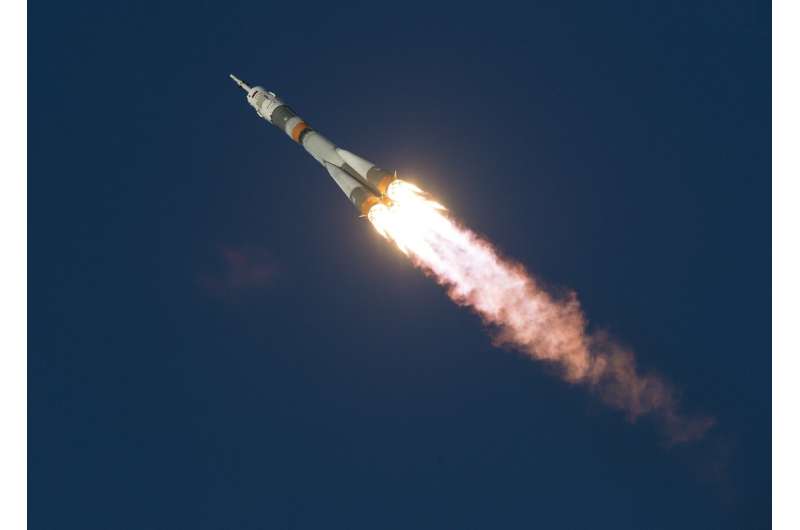
Copernical Team
Satellite data can help limit the dangers of windblown dust
 Interstate 10, an artery that cuts through the rural drylands of southern New Mexico, is one of the country's deadliest roadways. On one stretch of the highway, just north of a dry lakebed called Lordsburg Playa, fatal collisions occur with such regularity that officials often call it the "dust trap." It's a fitting name. Since 1967, at least 55 deaths in the area have been linked to dust storms
Interstate 10, an artery that cuts through the rural drylands of southern New Mexico, is one of the country's deadliest roadways. On one stretch of the highway, just north of a dry lakebed called Lordsburg Playa, fatal collisions occur with such regularity that officials often call it the "dust trap." It's a fitting name. Since 1967, at least 55 deaths in the area have been linked to dust storms NASA's PACE arrives in Florida for final processing for 2024 launch
 NASA's PACE spacecraft completed its journey Tuesday, Nov. 14, from NASA's Goddard Space Flight Center in Greenbelt, Maryland, to the Astrotech Spacecraft Operations facility near the agency's Kennedy Space Center in Florida.
Engineers and technicians arrived ahead of the spacecraft to prepare ground equipment for offloading and processing before fueling and final encapsulation.
PACE
NASA's PACE spacecraft completed its journey Tuesday, Nov. 14, from NASA's Goddard Space Flight Center in Greenbelt, Maryland, to the Astrotech Spacecraft Operations facility near the agency's Kennedy Space Center in Florida.
Engineers and technicians arrived ahead of the spacecraft to prepare ground equipment for offloading and processing before fueling and final encapsulation.
PACE Intelsat's MOTT proves its mettle in US Army's annual NetModX
 Intelsat (NYSE: I), a leading operator in the satellite and terrestrial network sector, recently showcased the robust capabilities of its Multi-Orbit Tactical Terminal (MOTT) in a significant field test conducted with the U.S. Army. This demonstration, part of the Army's annual Network Modernization Experiment (NetModX), highlighted the MOTT's ability to provide high-speed, uninterrupted satelli
Intelsat (NYSE: I), a leading operator in the satellite and terrestrial network sector, recently showcased the robust capabilities of its Multi-Orbit Tactical Terminal (MOTT) in a significant field test conducted with the U.S. Army. This demonstration, part of the Army's annual Network Modernization Experiment (NetModX), highlighted the MOTT's ability to provide high-speed, uninterrupted satelli EU Council endorses new Space Strategy for Enhanced Security and Defence
 In a landmark decision, the Council of the European Union has approved conclusions on the pioneering EU Space Strategy for Security and Defence. This strategy underscores the EU's commitment to fortifying its stance as a global space power amidst rising security challenges in the space domain.
The Council, an influential body comprising national ministers from each EU country, emphasized t
In a landmark decision, the Council of the European Union has approved conclusions on the pioneering EU Space Strategy for Security and Defence. This strategy underscores the EU's commitment to fortifying its stance as a global space power amidst rising security challenges in the space domain.
The Council, an influential body comprising national ministers from each EU country, emphasized t CubeSat launch platform by Vector Space Biosciences will boost space biotech
 In a new collaboration, Vector Space Biosciences, Inc. has joined forces with Oracle and NVIDIA to introduce a novel small satellite launch platform for CubeSat and NanoSats, that have been specifically designed to cater to the needs of the biotechnology and pharmaceutical sectors.
This innovative platform represents a combination of several cutting-edge technologies, including a bioscienc
In a new collaboration, Vector Space Biosciences, Inc. has joined forces with Oracle and NVIDIA to introduce a novel small satellite launch platform for CubeSat and NanoSats, that have been specifically designed to cater to the needs of the biotechnology and pharmaceutical sectors.
This innovative platform represents a combination of several cutting-edge technologies, including a bioscienc SUNY team finds alternative cosmic source of gold in published collaborative research
 Dr. Shing Chi Leung, SUNY Poly assistant professor of physics, in collaboration with Mr. Chun-Ming Yip, Dr. Ming-Chung Chu and Dr. Lap-Ming Lin, from the Chinese University of Hong Kong, published a peer reviewed article in The Astrophysical Journal. They discovered that the explosion of a low-mass neutron star can be the alternative cosmic source for the Lanthanides and other heavy elements, in
Dr. Shing Chi Leung, SUNY Poly assistant professor of physics, in collaboration with Mr. Chun-Ming Yip, Dr. Ming-Chung Chu and Dr. Lap-Ming Lin, from the Chinese University of Hong Kong, published a peer reviewed article in The Astrophysical Journal. They discovered that the explosion of a low-mass neutron star can be the alternative cosmic source for the Lanthanides and other heavy elements, in UK Space Agency backs Orbit Fab's innovative refueling interface, GRASP
 Orbit Fab, a frontrunner in on-orbit refueling services, has announced a pivotal partnership with the UK Space Agency to develop the GRASP (Grasping and Resupply Active Solution for Propellants) active refueling interface in the UK. This strategic collaboration aims to establish the necessary components for in-space refueling, a transformative concept set to redefine space mission operations.
Orbit Fab, a frontrunner in on-orbit refueling services, has announced a pivotal partnership with the UK Space Agency to develop the GRASP (Grasping and Resupply Active Solution for Propellants) active refueling interface in the UK. This strategic collaboration aims to establish the necessary components for in-space refueling, a transformative concept set to redefine space mission operations. N. Korea says spy satellite launch successful
 North Korea said Wednesday it had succeeded in putting a military spy satellite in orbit after two previous failures, as the US led its allies in condemning the launch as a "brazen violation" of UN sanctions.
A rocket carrying the satellite blasted off Tuesday night from North Phyongan province, flew along its designated path and "accurately put the reconnaissance satellite 'Malligyong-1' on
North Korea said Wednesday it had succeeded in putting a military spy satellite in orbit after two previous failures, as the US led its allies in condemning the launch as a "brazen violation" of UN sanctions.
A rocket carrying the satellite blasted off Tuesday night from North Phyongan province, flew along its designated path and "accurately put the reconnaissance satellite 'Malligyong-1' on Does spaceflight increase men's risk of erectile dysfunction?

During missions into space, astronauts are exposed to high levels of galactic cosmic radiation and weightlessness. Simulation experiments in male rats indicated that these aspects of spaceflight can negatively affect vascular tissues relevant to erectile dysfunction, even after a period of long-term recovery.
The research, which is published in The FASEB Journal, indicated that vascular alterations are induced by relatively low doses of galactic cosmic radiation and, to a lesser extent, simulated weightlessness, primarily through increases in oxidative stress. Treatment with different antioxidants could counter some of these effects.
"With manned missions to outer space planned for the coming years, this work indicates that sexual health should be closely monitored in astronauts upon their return to Earth," said corresponding author Justin D. La Favor, Ph.D., of Florida State University. "While the negative impacts of galactic cosmic radiation were long-lasting, functional improvements induced by acutely targeting the redox and nitric oxide pathways in the tissues suggest that the erectile dysfunction may be treatable."
More information: Neurovascular dysfunction associated with erectile dysfunction persists after long-term recovery from simulations of weightlessness and deep space irradiation, The FASEB Journal (2023).
Unlocking Europe’s satellite navigation potential at NAVISP Industry Days

Leading positioning, navigation and timing experts from companies and research institutions across Europe met last week at ESA’s NAVISP Industry Days, a two-day workshop dedicated to discussing trends and opportunities in this field.

































